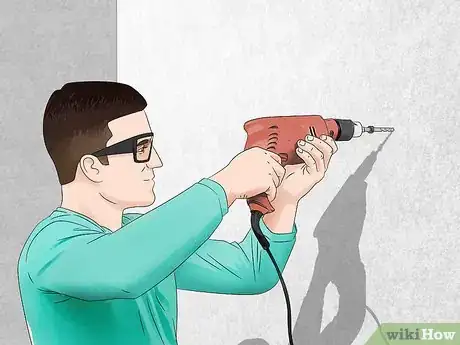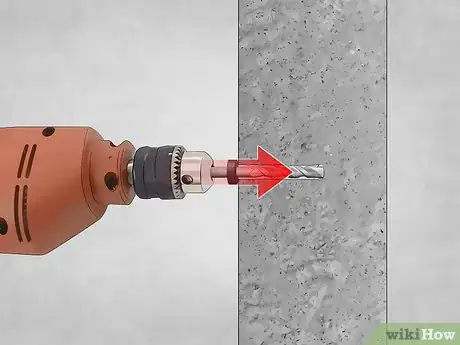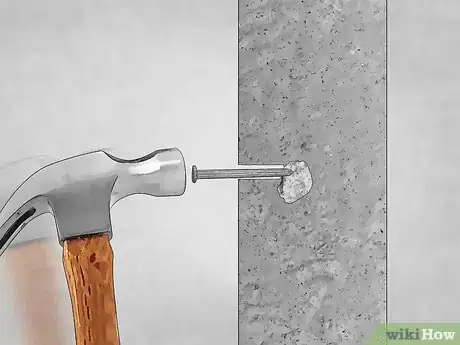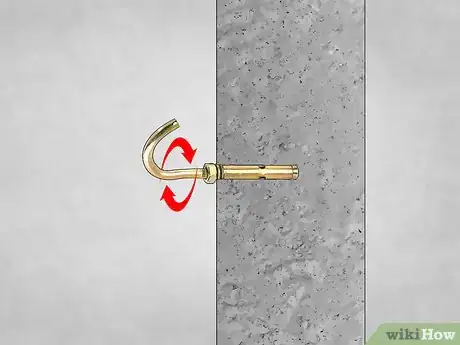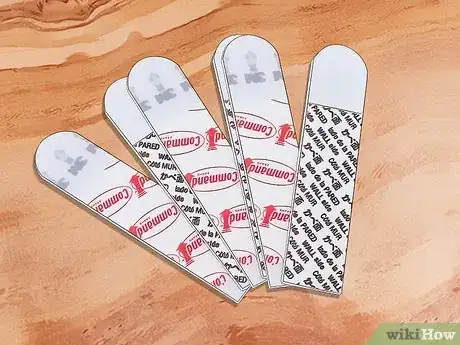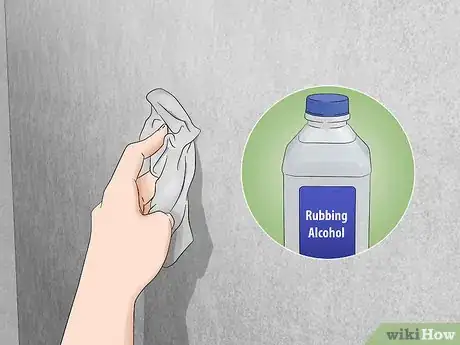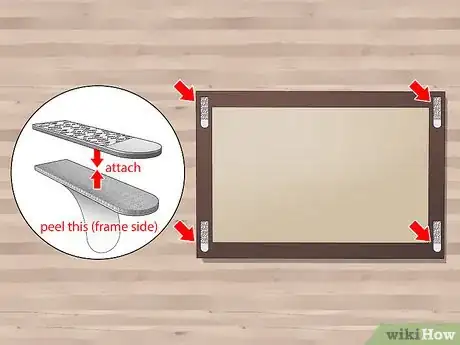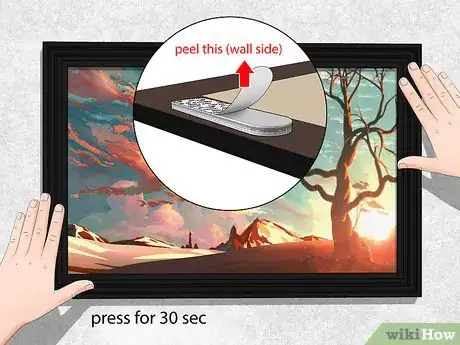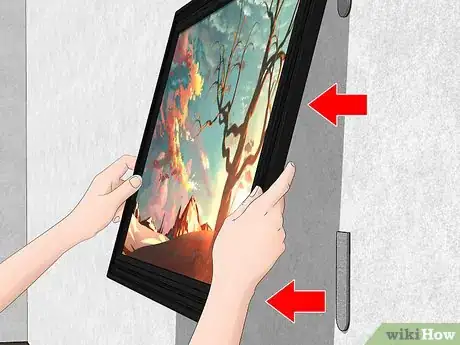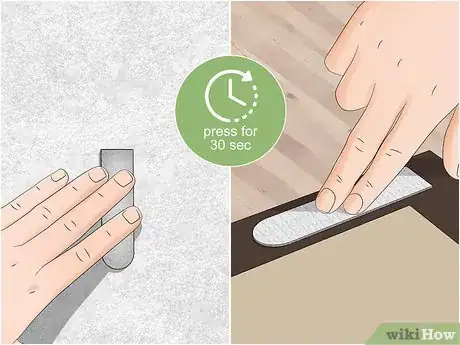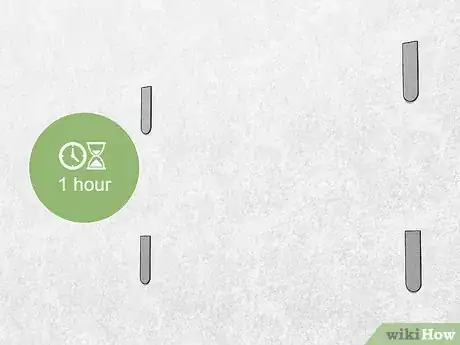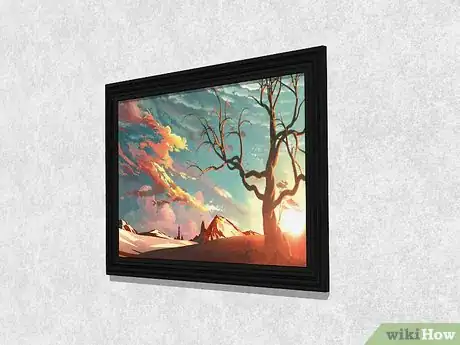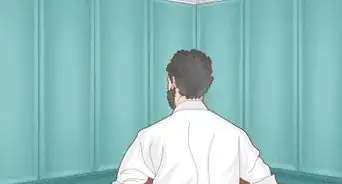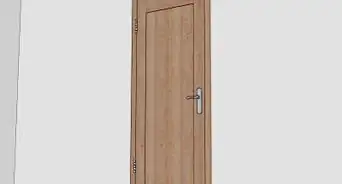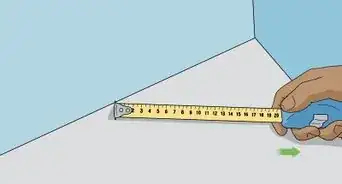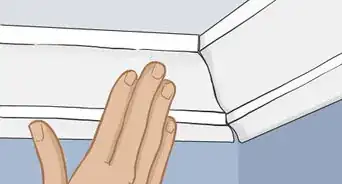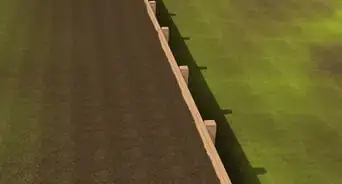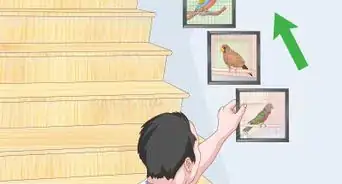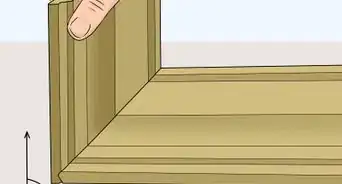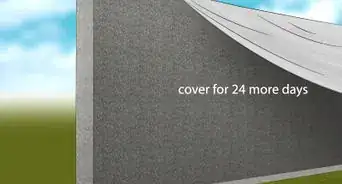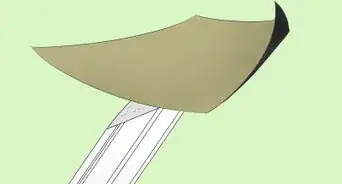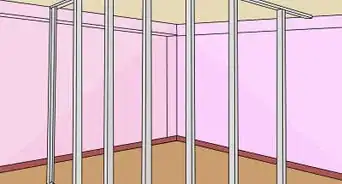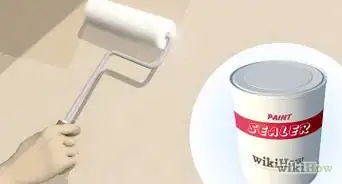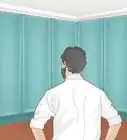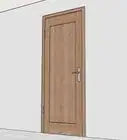This article was co-authored by Peter Salerno. Peter Salerno is the owner of Hook it Up Installation, a professional installation company, which has been hanging art and other objects around Chicago, Illinois for over 10 years. Peter also has over 20 years of experience installing art and other mountable objects in residential, commercial, healthcare and hospitality contexts.
There are 11 references cited in this article, which can be found at the bottom of the page.
This article has been viewed 21,380 times.
Concrete walls have become more and more popular over the last decade for their durability and modern look. Because of their durability, though, it can be difficult to hang pictures on them. Thankfully, there are several different ways you can get those pictures up on the wall. For objects that weigh more than 8 pounds (3.6 kg), use a drill and anchor. For objects that weigh less than 8 pounds (3.6 kg), use adhesive strips. With a little time and patience, you can securely hang pictures from your attractive concrete walls!
Steps
Drilling and Using a Threaded Anchor for Heavy Pictures
-
1Mark the positions for the holes for your picture on the concrete wall. Depending on how large your picture is, you may need 1, 2, or even 3 holes to support it. Generally, you can measure the length of the picture and plan to make 1 hole at the center point. If you're going to use more than 1 hole, space them out evenly along the length of the picture.[1]
- For pictures that weigh less than 50 pounds (23 kg), 1 hole should provide enough support. If it weighs more than that, consider using 2 or 3 holes.
- Also consider the length of the picture. For extremely wide pieces, you may want 2 or 3 holes just to ensure that the photo won't easily become crooked.
- If you do choose to make more than 1 hole, use a level to ensure they're at equal heights on the wall. If they aren't, your picture will hang crooked.
-
2Set the stop-bar on your hammer drill at the appropriate depth. Check the length of the threaded anchor you're going to use. That length is the minimum depth that your hole needs to be. Avoid setting the stop-bar much further than that point to avoid unnecessary drilling.[2]
- If your drill doesn't have a stop-bar, you can use a piece of masking tape to mark the stopping point on the actual masonry bit.
- Hammer drills are the best option for drilling into concrete. They combine the pounding of a hammer and the rotation of a drill to make the drilling a bit easier. If you don't have one or can't rent one, a rotary drill will also work.
Advertisement -
3Hold the drill in both hands and place your feet shoulder-width apart. The proper stance is really important to your safety and to accurately drilling that hole into the concrete wall. You need to be able to drill straight into the wall rather than at an angle. Also put on protective eyewear before you actually start drilling to protect your eyes from concrete bits and dust.[3]
- If the spot for the hole is too high for you to reach without having the drill at an angle, use a step-stool or ladder. Just be sure to be safe and have someone hold the ladder for you if you need some extra stability.
- Even if you wear glasses, you still need to put on safety goggles. Dust and concrete could fly around the rim of your glasses and injure your eyes.
-
4Create an 1⁄8 to 1⁄4 in (0.32 to 0.64 cm) deep guide hole. Use your masonry bit on the lowest speed setting to create the guide hole before you actually make the rest of the hole. This will help perforate that hard concrete exterior and will make the rest of the drilling easier.[4]
- The low speed will actually give you a little more control to get your hole started without potentially damaging your drill bit.
-
5Turn up the power and make your hole in the concrete wall. Using the same masonry bit, choose the highest drill setting (most drills only have 2 or 3 settings), and push straight into the guide hole. Try to keep the drill as even as possible so it doesn't go in at an angle. Use slow, steady movements, and keep pushing the drill forward until you hit the stop-depth mark.[5]
- If you need to, stop along the way to blow away excess dust.
-
6Break up obstructions in the hole with a hammer and masonry nail. This may not be an issue, but if you run into any really hard obstructions, like a rock or stone, that you can't push through with regular force, stop drilling. Take a long masonry nail and your hammer, and chip away at the blockage until it is broken up into smaller pieces. Then you can resume drilling.[6]
- You probably won't run across this issue if you're dealing with a newer wall. For older concrete walls from 50 or so years ago, though, you might have more blockages come up.
- Trying to force the drill could really damage the masonry bit.
-
7Fit a threaded anchor and screw into the hole. If you notice any dust or grit, blow into the hole first or use a can of compressed air to clear it out. You may need to lightly hammer the anchor to get it fully into the hole, which is okay. Insert the screw by hand, or use a cordless drill to get it into place.[7]
- The threaded anchor is super important for securely hanging pictures on the wall—it will keep the screw in place and prevent it from slipping out from the weight of the picture.
-
8Hang up your picture and check that it's level. Once the threaded anchor and screw are in place, you're ready to get that picture up on the wall! Hang it up, then use a level to make sure it's even all the way across. Reposition as needed, and enjoy![8]
- In all, it should only take you several minutes to drill into a concrete wall and hang up your picture.
- Don't forget to vacuum up the concrete residue from the ground.
Using Adhesive Strips for Lightweight Pictures
-
1Purchase adhesive strips that can support the weight of your picture. Luckily, most pictures don't weigh a ton unless they're inside a really heavy frame. Check out your local hardware store to buy strips that are the appropriate size for the thing you need to hang; the weight limit will be clearly posted on the package.[9]
- These strips are made specifically for hanging pictures or similar objects from the wall. Normal double-sided tape won't work for this purposes.
- Most adhesive strips can't hold objects that weight more than 8 pounds (3.6 kg). You'd be best off drilling a hole into the concrete and using anchor hooks if your picture weighs more than that.
-
2Clean the surface area of the wall with rubbing alcohol. Decide where you want to hang your picture, and clean the areas that will have the strips on them. This will help the adhesive attach to the wall more securely. Use rubbing alcohol and a clean, lint-free towel or cotton balls.[10]
- If the frame you're using is dirty or dusty, clean the back edges of it, too, so that the adhesive will stick to it better.
-
3Secure the adhesive strips to each corner on the back of the frame. Each brand of adhesive strips has its own instructions, so make sure to read the package to make sure you're doing it correctly. For many brands, there will be 2 parts: 1 will be attached to the back of the frame and 1 will stick on the wall. To keep things lined up, go ahead and “click” together the 2 pieces, and then attach them to the back of the frame.[11]
- A strip at each corner of the frame will help the picture stay in place securely, though you could add more across the top of the frame if you prefer.
- The size of the actual strip doesn't matter, as long as it isn't visible from behind the frame. Just remember to pick a strip that can support the weight of the picture you're wanting to hang.
-
4Position the picture on the wall and press it down for 30 seconds. Remove the liner from the back of each strip so the adhesive is exposed. Then use a level to position the picture to ensure it is straight all the way across. Once you know it's level, go ahead and press the picture onto the wall and lean against it for 30 to 60 seconds to start the adhesive process.[12]
- It's really important that you follow the time directions, so if you tend to count quickly, count to 60 seconds instead of 30. Or, use a timer on your phone.
-
5Lift the frame from the bottom so the fasteners come undone. After the initial pressing, grip the bottom of the frame and pull it back toward you so that the strips detach from each other. The detaching will remind you of velcro coming undone.[13]
- Once the frame is back off the wall, there will be strips stuck to the wall as well as to the back of the frame.
-
6Press each strip down for 30 seconds, both on the wall and the frame. Every strip on the wall and every strip on the frame should receive an additional 30 seconds of pressure to secure it in place. Set your timer or count out loud slowly to give each strip the time it needs.[14]
- Again, most adhesive strips have similar instructions, but if your packet specifies anything different, follow those directions.
-
7Set a timer for 1 hour and let the adhesive adhere to the wall. Before putting the picture back on the wall, the strips need more time to cement themselves in place. If you leave them for longer than 1 hour that is okay, too.[15]
-
8Remount the picture by aligning the strips and clicking them in place. After the 1 hour of time has passed, it's time to put your photo on the wall! This should be as simple as lining up the strips on the back of the picture to the ones on the wall, and pressing them together until you hear them “click” back into place.[16]
- A lot of strips come with tabs you can pull to safely remove them from the wall without leaving adhesive behind. If you need to permanently remove your picture, use these tabs to get the strips off of the wall.
Expert Q&A
-
QuestionDo you need a drill to hang things on a concrete wall?
 Peter SalernoPeter Salerno is the owner of Hook it Up Installation, a professional installation company, which has been hanging art and other objects around Chicago, Illinois for over 10 years. Peter also has over 20 years of experience installing art and other mountable objects in residential, commercial, healthcare and hospitality contexts.
Peter SalernoPeter Salerno is the owner of Hook it Up Installation, a professional installation company, which has been hanging art and other objects around Chicago, Illinois for over 10 years. Peter also has over 20 years of experience installing art and other mountable objects in residential, commercial, healthcare and hospitality contexts.
Installation Expert For the best results, use a hammer drill with a carbide percussive concrete bit. If you use a standard drill bit, it's going to break.
For the best results, use a hammer drill with a carbide percussive concrete bit. If you use a standard drill bit, it's going to break.
Warnings
- Always use protective eyewear when you're working with a drill and concrete. Little bits of concrete could fly into your eyes, causing irritation and injury.⧼thumbs_response⧽
Things You'll Need
Drilling and Using a Threaded Anchor for Heavy Pictures
- Pencil or marker
- Ruler
- Hammer drill
- Goggles
- Tungsten carbide masonry bits
- Masonry nail
- Hammer
- Threaded anchor(s)
- Screw(s)
- Level
Using Adhesive Strips for Lightweight Pictures
- Adhesive strips
- Cotton balls or lint-free towel
- Rubbing alcohol
- Level
References
- ↑ https://youtu.be/VPz80DaOjcY?t=126
- ↑ https://www.bobvila.com/articles/how-to-drill-into-concrete/
- ↑ https://www.bobvila.com/articles/how-to-drill-into-concrete/
- ↑ https://www.bobvila.com/articles/how-to-drill-into-concrete/
- ↑ https://youtu.be/VPz80DaOjcY?t=336
- ↑ https://www.bobvila.com/articles/how-to-drill-into-concrete/
- ↑ https://www.bobvila.com/articles/picture-hanging-tips/?
- ↑ https://www.bobvila.com/articles/picture-hanging-tips/?
- ↑ https://youtu.be/FHQrCgRhl_k?t=11
- ↑ https://youtu.be/FHQrCgRhl_k?t=17
- ↑ https://youtu.be/FHQrCgRhl_k?t=37
- ↑ https://youtu.be/FHQrCgRhl_k?t=49
- ↑ https://youtu.be/FHQrCgRhl_k?t=54
- ↑ https://youtu.be/FHQrCgRhl_k?t=63
- ↑ https://youtu.be/FHQrCgRhl_k?t=63
- ↑ https://youtu.be/FHQrCgRhl_k?t=70
- ↑ https://www.bobvila.com/articles/how-to-drill-into-concrete/


